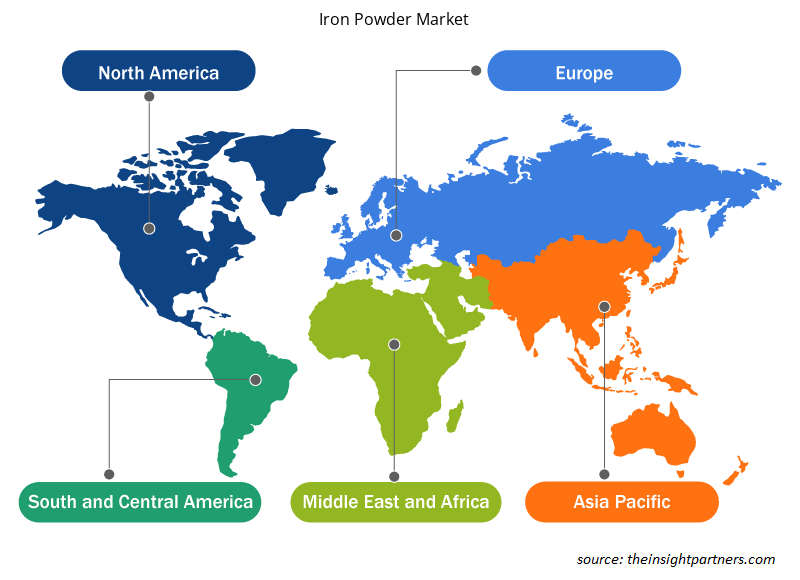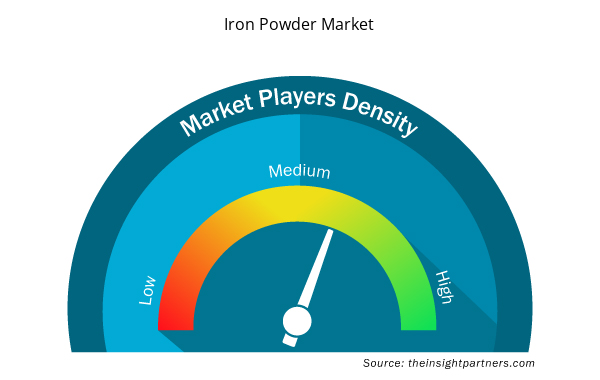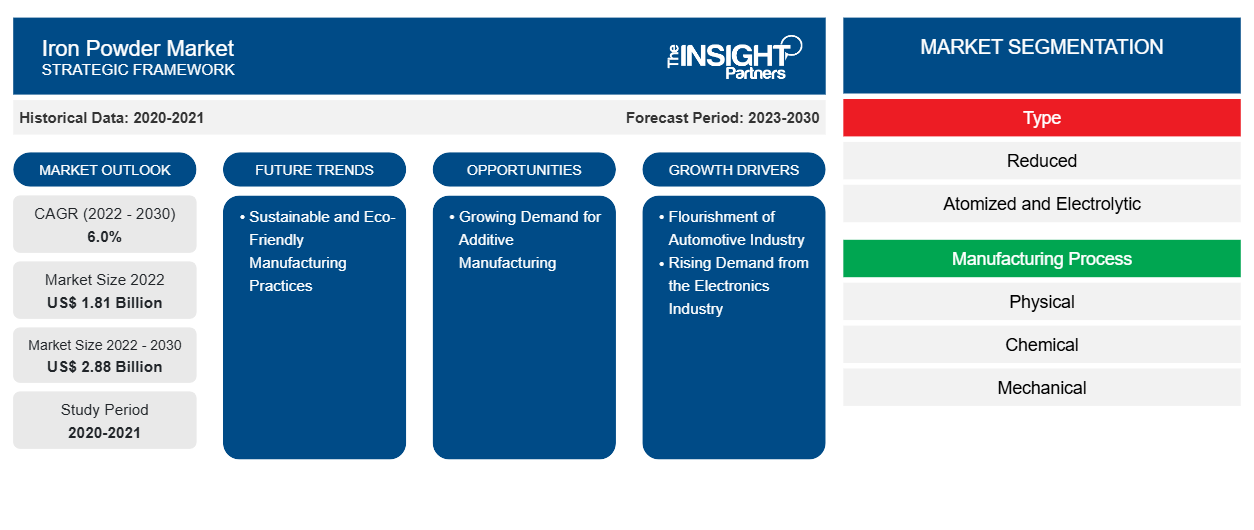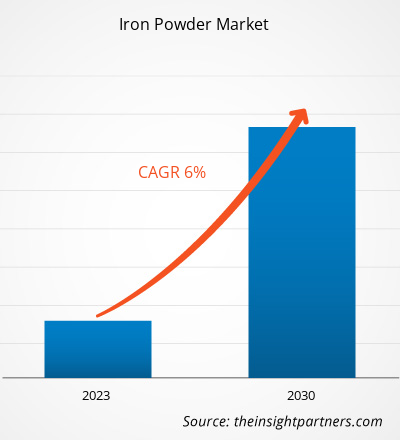[研究报告] 2022年铁粉市场规模价值18.0632亿美元,预计到2030年将达到28.8031亿美元;预计2022年至2030年的复合年增长率为6.0%。
市场洞察和分析师观点:
铁粉是一种细磨的铁,由微小的单个金属颗粒组成。这种物质是通过还原氧化铁(通常以铁矿石或铁锈的形式存在)而产生的,使用的过程涉及加热,有时使用碳或氢作为还原剂。所得的铁粉通常为灰色至黑色,由于颗粒小而具有高反应性。它在各个行业中都有广泛的应用。铁粉广泛用于制造铁基产品,例如铁合金和钢。它通常与其他金属或材料混合以制造具有特定性能的定制合金,例如增加强度或耐腐蚀性。铁粉还用于生产烧结部件,这些部件经过压实和加热以制造汽车制造等行业的零件。汽车行业严重依赖铁粉,因为它是粉末冶金领域的基本原材料。该制造工艺涉及成型和烧结金属粉末以制造复杂的零件。汽车制造商越来越多地采用粉末冶金来生产齿轮、轴承和衬套等部件,因为它提供了经济高效、精确且资源高效的制造解决方案。此外,近年来,汽车行业在减轻车辆重量方面投入了大量资金,以提高燃油效率并减少排放。铁粉与金属基复合材料和其他先进材料相结合,有助于开发保持结构完整性的轻质部件。所有这些因素都促进了铁粉市场的增长。
增长动力和挑战:
铁粉市场经历了显着增长,主要受电子行业需求增长的推动。电子行业在各种应用中严重依赖铁粉,例如制造电感器和变压器。这些组件对于智能手机、计算机和电源等电子设备的运行至关重要。随着消费电子产品的不断发展和普及,对高质量铁粉的需求不断上升。此外,电子行业的小型化趋势带来了对更小、更高效组件的需求。铁粉非常适合此目的,因为它可以进行精细调整以满足特定要求,例如磁性和粒度分布。这种多功能性使铁粉对生产紧凑、高性能电子设备的制造商具有吸引力。此外,对可再生能源和电动汽车的推动进一步推动了对铁粉的需求。这些技术中使用的电动机和发电机通常依靠铁粉芯的磁性来提高效率并减少能量损失。
随着电子设备变得越来越先进和互联,它们会产生更高水平的电磁辐射。这种辐射会干扰附近电子元件的正常运行,导致性能和可靠性下降。所有这些因素都导致了铁粉市场的增长。
然而,原材料价格波动对铁粉市场的增长构成了重大制约。这种波动主要源于铁矿石和能源等基本投入品价格的波动,并在整个行业产生反响,影响其运营的多个方面。铁粉制造商严重依赖稳定的成本结构来有效地规划生产流程。然而,当原材料价格发生不可预测的变化时,准确估计生产成本就变得极具挑战性。因此,制造商被迫在高度不确定的情况下运营,这可能导致利润率下降和财务不稳定。其影响不仅限于成本考虑。原材料价格波动也会影响投资决策,从而扰乱铁粉市场的增长轨迹。当原材料成本仍然不可预测时,公司可能会犹豫是否投资扩大生产能力或开发新技术。这种犹豫会限制创新,并限制行业满足不断增长的需求的能力。这些因素可能会限制铁粉市场的增长。
定制此报告以满足您的需求
您可以免费定制任何报告,包括本报告的部分内容、国家级分析、Excel 数据包,以及为初创企业和大学提供优惠和折扣
- 获取此报告的关键市场趋势。这个免费样品将包括数据分析,从市场趋势到估计和预测。
报告细分和范围:
“2030 年铁粉市场分析”是一项专业而深入的研究,主要关注全球铁粉市场趋势和全球增长机会。该报告旨在概述铁粉市场,并按应用和最终用途对市场进行详细细分。全球铁粉市场近年来经历了高增长,预计在预测期内将继续保持这一趋势。该报告提供了全球铁粉消费的关键统计数据。此外,该报告还对影响全球铁粉市场表现的各种因素进行了定性评估。该报告还包括对全球铁粉市场主要参与者及其关键战略发展的全面分析。还包括对市场动态的几项分析,以帮助确定关键驱动因素、市场趋势和有利可图的机会,进而有助于确定主要收入来源。
此外,生态系统分析和波特五力分析提供了全球铁粉市场的360度视角,有助于了解整个供应链和影响市场增长的各种因素。
节段分析:
全球铁粉市场根据类型、制造工艺、等级、最终用途行业和地理位置进行细分。根据类型,市场分为还原、雾化和电解。就制造工艺而言,市场细分为物理 [雾化和电沉积]、化学 [还原和分解] 和机械。根据等级,市场分为 ≤ 99.0% 和 ≥ 99.1%。就最终用途行业而言,市场细分为油漆和涂料、增材制造、医疗、软磁产品、冶金 [复合钎焊、复合烧结、复合焊接等] 和其他。增材制造领域预计将在 2022 年至 2030 年期间实现显着增长。铁粉是增材制造领域(也称为 3D 打印)的关键材料,因为它具有多种应用和优异的性能。这种细粉状的铁可用于各种增材制造工艺,例如粉末床熔合和粘合剂喷射,以制造复杂而耐用的金属部件。铁粉在增材制造中的重要用途是为航空航天和汽车等行业生产高强度轻质零件。通过将铁粉与合金元素混合,可以合成铁基合金,例如不锈钢或工具钢,所得部件具有出色的机械性能、耐腐蚀性和耐热性。
铁粉的磁性使其成为制造电磁元件和传感器不可或缺的材料,因为这些元件和传感器的几何形状非常精确。铁粉在增材制造过程中易于烧结或熔合,因此可以精确地制造复杂、定制的磁性设备。所有这些因素都在推动增材制造领域的增长,从而推动铁粉市场的增长。
区域分析:
根据地理位置,铁粉市场分为五个主要区域——北美、欧洲、亚太、南美和中美以及中东和非洲。市场以亚太地区为主,2022 年该地区的市场规模约为 7 亿美元。该地区为铁粉的增长提供了大量机会。外国直接投资的增加也促进了该地区的经济增长。铁粉在冶金、涂层和装饰、电子材料、烧结零件、金刚石切削工具等众多应用中的使用日益增多,预计将使亚太地区的铁粉需求激增。
电气化领域的项目不断增加,加上亚太地区电子行业的增长,预计将在 2022-2030 年期间推动亚太地区铁粉市场的增长。预计欧洲在 2022 年至 2030 年的复合年增长率将超过 6.0%。由于欧盟对可持续发展和环境目标的承诺,欧洲对铁粉的需求一直在显着增长。铁粉被认为是各种应用中传统材料的环保替代品。所有这些因素都在推动欧洲铁粉市场的增长。此外,预计到 2030 年北美将达到 600 美元。随着许多汽车制造商转向电动汽车生产,对铁粉的需求激增,因为它是电动机制造和电池技术的关键组成部分。例如,特斯拉在美国扩建超级工厂导致铁粉消费量大幅上升,反映了该地区电动汽车市场的强劲增长,进一步推动了铁粉市场的增长。
行业发展和未来机遇:
以下列出了铁粉市场主要参与者采取的各种举措:
- 2023年5月,江西粤安新材料有限公司开始建设一条新的羰基铁粉(CIP)生产线。新的CIP装置的生产能力为每年6,000公吨。
铁粉市场区域洞察
Insight Partners 的分析师已详细解释了预测期内影响铁粉市场的区域趋势和因素。本节还讨论了北美、欧洲、亚太地区、中东和非洲以及南美和中美洲的铁粉市场细分和地理位置。

- 获取铁粉市场的区域具体数据
铁粉市场报告范围
| 报告属性 | 细节 |
|---|---|
| 2022 年市场规模 | 18.1亿美元 |
| 2030 年的市场规模 | 28.8亿美元 |
| 全球复合年增长率(2022 - 2030 年) | 6.0% |
| 史料 | 2020-2021 |
| 预测期 | 2023-2030 |
| 涵盖的领域 | 按类型
|
| 覆盖地区和国家 | 北美
|
| 市场领导者和主要公司简介 |
|
铁粉市场参与者密度:了解其对业务动态的影响
铁粉市场正在快速增长,这得益于终端用户需求的不断增长,而这些需求又源于消费者偏好的不断变化、技术进步以及对产品优势的认识不断提高等因素。随着需求的增加,企业正在扩大其产品范围,进行创新以满足消费者的需求,并利用新兴趋势,从而进一步推动市场增长。
市场参与者密度是指在特定市场或行业内运营的企业或公司的分布情况。它表明在给定市场空间中,相对于其规模或总市场价值,有多少竞争对手(市场参与者)存在。
在铁粉市场运营的主要公司有:
- SK Rio Tinto 金属粉末
- 美国元素公司
- 工业金属粉末(印度)私人有限公司
- 中石油粉体北美公司
- 阿什兰公司
免责声明:上面列出的公司没有按照任何特定顺序排列。

- 了解铁粉市场顶级关键参与者概况
COVID-19 影响:
COVID-19 疫情对各国几乎所有行业都产生了不利影响。北美、欧洲、亚太地区 (APAC)、南美和中美以及中东和非洲 (MEA) 的封锁、旅行限制和企业关闭阻碍了包括化学和材料行业在内的多个行业的增长。铁粉公司制造部门的关闭扰乱了全球供应链、制造活动和交付计划。各公司报告称,2020 年产品交付延迟,产品销售下滑。疫情期间,大多数工业制造设施关闭,减少了铁粉的消耗。此外,COVID-19 疫情导致铁粉价格波动。然而,在供应限制得到解决后,各行业恢复了运营,从而导致市场复苏。此外,油漆和涂料、增材制造和医疗行业对铁粉的需求不断增长,大大促进了铁粉市场的增长。
竞争格局和重点公司:
力拓金属粉末公司、American Elements Inc、Industrial Metal Powders (India) Pvt Ltd、CNPC Powder North America Inc、Ashland Inc、BASF SE、Hoganas AB、JFE Steel Corp、Reade International Corp 和 Kobe Steel Ltd 是全球铁粉市场的参与者。市场参与者专注于提供高质量的产品以满足客户需求。
- 历史分析(2 年)、基准年、预测(7 年)及复合年增长率
- PEST 和 SWOT 分析
- 市场规模价值/数量 - 全球、区域、国家
- 行业和竞争格局
- Excel 数据集



Report Coverage
Revenue forecast, Company Analysis, Industry landscape, Growth factors, and Trends

Segment Covered
This text is related
to segments covered.

Regional Scope
North America, Europe, Asia Pacific, Middle East & Africa, South & Central America

Country Scope
This text is related
to country scope.
常见问题
The growing demand for additive manufacturing, also known as 3D printing, presents significant growth opportunities for the iron powder market. This transformative technology is revolutionizing industries across the globe, and iron powder is emerging as a key material to meet the unique requirements of 3D printing applications. Additive manufacturing is experiencing widespread adoption across various sectors, including aerospace, automotive, and healthcare. This adoption is driven by the ability of 3D printing to produce complex and customized parts with precision and efficiency.
Based on type, the iron powder market is segmented into reduced, atomized, and electrolytic. The atomized segment held the largest market share in 2022. Atomized iron powder is produced using a specialized atomization process. In this process, molten iron is subjected to high-pressure gas or water jets, causing it to break up into fine droplets or particles. These droplets rapidly solidify into small, spherical, or irregularly shaped powder particles as they cool down.
The major players operating in the global iron powder market are Rio Tinto Metal Powders, American Elements Inc, Industrial Metal Powders (INDIA) Pvt Ltd, CNPC Powder North America Inc, Ashland Inc, BASF SE, Hoganas AB, JFE Steel Corp, Reade International Corp, Kobe Steel Ltd.
The automotive industry heavily relies on iron powder as it is a fundamental raw material in the field of powder metallurgy. This manufacturing process involves shaping and sintering metal powders to create intricate parts. Automotive manufacturers increasingly turn to powder metallurgy for the production of components such as gears, bearings, and bushings, as it offers cost-effective, precise, and resource-efficient manufacturing solutions.
Asia Pacific accounted for the largest share of the global iron powder market. Asia Pacific is one of the most significant regions for the iron powder market owing to drastic increase in the demand for passenger vehicles.
Based on application, the iron powder market is segmented into paints and coatings, additive manufacturing, medical, soft magnetic products, metallurgy and other. The iron powder market share of the additive manufacturing segment was notable in 2022. Iron powder is a crucial material in the realm of additive manufacturing, also known as 3D printing, due to its versatile applications and excellent properties. This finely powdered form of iron is employed in various additive manufacturing processes, such as powder bed fusion and binder jetting, to create intricate and durable metal components.
Trends and growth analysis reports related to Chemicals and Materials : READ MORE..
The List of Companies - Iron Powder Market
- SK Rio Tinto Metal Powders
- American Elements Inc
- Industrial Metal Powders (INDIA) Pvt Ltd
- CNPC Powder North America Inc
- Ashland Inc
- BASF SE
- Hoganas AB
- JFE Steel Corp
- Reade International Corp
- Kobe Steel Ltd
The Insight Partners performs research in 4 major stages: Data Collection & Secondary Research, Primary Research, Data Analysis and Data Triangulation & Final Review.
- Data Collection and Secondary Research:
As a market research and consulting firm operating from a decade, we have published and advised several client across the globe. First step for any study will start with an assessment of currently available data and insights from existing reports. Further, historical and current market information is collected from Investor Presentations, Annual Reports, SEC Filings, etc., and other information related to company’s performance and market positioning are gathered from Paid Databases (Factiva, Hoovers, and Reuters) and various other publications available in public domain.
Several associations trade associates, technical forums, institutes, societies and organization are accessed to gain technical as well as market related insights through their publications such as research papers, blogs and press releases related to the studies are referred to get cues about the market. Further, white papers, journals, magazines, and other news articles published in last 3 years are scrutinized and analyzed to understand the current market trends.
- Primary Research:
The primarily interview analysis comprise of data obtained from industry participants interview and answers to survey questions gathered by in-house primary team.
For primary research, interviews are conducted with industry experts/CEOs/Marketing Managers/VPs/Subject Matter Experts from both demand and supply side to get a 360-degree view of the market. The primary team conducts several interviews based on the complexity of the markets to understand the various market trends and dynamics which makes research more credible and precise.
A typical research interview fulfils the following functions:
- Provides first-hand information on the market size, market trends, growth trends, competitive landscape, and outlook
- Validates and strengthens in-house secondary research findings
- Develops the analysis team’s expertise and market understanding
Primary research involves email interactions and telephone interviews for each market, category, segment, and sub-segment across geographies. The participants who typically take part in such a process include, but are not limited to:
- Industry participants: VPs, business development managers, market intelligence managers and national sales managers
- Outside experts: Valuation experts, research analysts and key opinion leaders specializing in the electronics and semiconductor industry.
Below is the breakup of our primary respondents by company, designation, and region:

Once we receive the confirmation from primary research sources or primary respondents, we finalize the base year market estimation and forecast the data as per the macroeconomic and microeconomic factors assessed during data collection.
- Data Analysis:
Once data is validated through both secondary as well as primary respondents, we finalize the market estimations by hypothesis formulation and factor analysis at regional and country level.
- Macro-Economic Factor Analysis:
We analyse macroeconomic indicators such the gross domestic product (GDP), increase in the demand for goods and services across industries, technological advancement, regional economic growth, governmental policies, the influence of COVID-19, PEST analysis, and other aspects. This analysis aids in setting benchmarks for various nations/regions and approximating market splits. Additionally, the general trend of the aforementioned components aid in determining the market's development possibilities.
- Country Level Data:
Various factors that are especially aligned to the country are taken into account to determine the market size for a certain area and country, including the presence of vendors, such as headquarters and offices, the country's GDP, demand patterns, and industry growth. To comprehend the market dynamics for the nation, a number of growth variables, inhibitors, application areas, and current market trends are researched. The aforementioned elements aid in determining the country's overall market's growth potential.
- Company Profile:
The “Table of Contents” is formulated by listing and analyzing more than 25 - 30 companies operating in the market ecosystem across geographies. However, we profile only 10 companies as a standard practice in our syndicate reports. These 10 companies comprise leading, emerging, and regional players. Nonetheless, our analysis is not restricted to the 10 listed companies, we also analyze other companies present in the market to develop a holistic view and understand the prevailing trends. The “Company Profiles” section in the report covers key facts, business description, products & services, financial information, SWOT analysis, and key developments. The financial information presented is extracted from the annual reports and official documents of the publicly listed companies. Upon collecting the information for the sections of respective companies, we verify them via various primary sources and then compile the data in respective company profiles. The company level information helps us in deriving the base number as well as in forecasting the market size.
- Developing Base Number:
Aggregation of sales statistics (2020-2022) and macro-economic factor, and other secondary and primary research insights are utilized to arrive at base number and related market shares for 2022. The data gaps are identified in this step and relevant market data is analyzed, collected from paid primary interviews or databases. On finalizing the base year market size, forecasts are developed on the basis of macro-economic, industry and market growth factors and company level analysis.
- Data Triangulation and Final Review:
The market findings and base year market size calculations are validated from supply as well as demand side. Demand side validations are based on macro-economic factor analysis and benchmarks for respective regions and countries. In case of supply side validations, revenues of major companies are estimated (in case not available) based on industry benchmark, approximate number of employees, product portfolio, and primary interviews revenues are gathered. Further revenue from target product/service segment is assessed to avoid overshooting of market statistics. In case of heavy deviations between supply and demand side values, all thes steps are repeated to achieve synchronization.
We follow an iterative model, wherein we share our research findings with Subject Matter Experts (SME’s) and Key Opinion Leaders (KOLs) until consensus view of the market is not formulated – this model negates any drastic deviation in the opinions of experts. Only validated and universally acceptable research findings are quoted in our reports.
We have important check points that we use to validate our research findings – which we call – data triangulation, where we validate the information, we generate from secondary sources with primary interviews and then we re-validate with our internal data bases and Subject matter experts. This comprehensive model enables us to deliver high quality, reliable data in shortest possible time.


 获取此报告的免费样本
获取此报告的免费样本